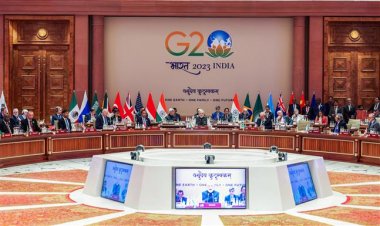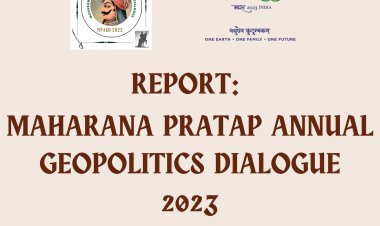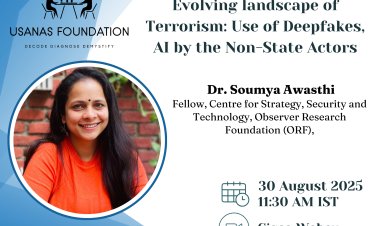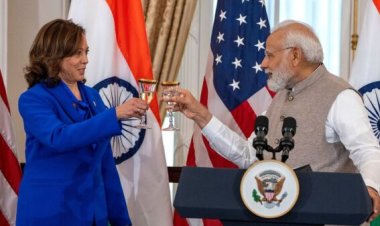China’s Salami-Slicing- A Fine Tool of Oriental Statecraft
Takeaways from 28th May 2022 lecture at the international conference organized by the National Youth Movement for the West Philippine Sea.

Mr. Abhinav Pandya Founder and CEO, Usanas Foundation spoke on China’s salami-slicing tactics in the Himalayan region and Lessons for the West Philippines Sea. Barring the factual details and insights about the Chinese incursions in Ladakh and the Himalayan region, the most crucial aspect that was addressed in the lecture is the concept of Salami-slicing and the fundamental philosophy underlying it.
- At its core, China’s salami-slicing manifests a much deeper philosophy/International Relations theory/war doctrine in the operational and tactical domains. The root theory is from Tsun Zue’s wisdom, i.e., winning the war without fighting or the armies should march only in the victory parades. Further developed, it found expression in Li’s concept- China’s core controls the periphery through economic, cultural, and trade linkages. In the military domain, it can be summarised as the “go” game- slower build-up to inflict progressive losses on the enemy implying taking fewer risks; however, with incremental steps.
- Following the above-mentioned dictums, China’s salami-slicing literally meaning nibbling away implies slow, gradual, and incremental occupation of the enemy’s territory accompanied by spells of tactical retreats as and when required depend upon the enemy’s deterrence and force posture. The cumulative result of such slow and gradual moves over a period of time results in strategic transformation and tactical gains that further China’s geopolitical objectives. Through salami-slicing tactics, China has captured Tibet, Xinjiang, Siberia, and Mongolia. In the South China Sea, it has captured the Mischief reef, Johnson reef, Scarborough Shoal, and other maritime features claimed by several countries, including the Philippines, Indonesia, Vietnam, and Japan.
- Such slow and gradual moves agitate the enemy but are insufficient to escalate the conflict to a major action or a full-fledged war. Such moves are not big enough to invite any military or diplomatic intervention from the global powers. Most of the time, they pass off as some minor territorial disputes over land or fishing rights. The deeper and sinister long-range designs of territorial acquisition and control are conveniently hidden without raising suspicions. With such moves, China also tests the patience of the enemy, and the moment it fears stiff resistance, it comes up with an offer for peace negotiations and tactical retreat. However, after every such episode, it ends up acquiring some more territory from the enemy. For ex., in India’s case, it has been a time-tested strategy of China to occupy ten miles and retreat five miles when Indians resist or make noise. However, Beijing always ends with some more territory.
- In salami-slicing tactics, the technique of illusion and creating smokescreens is at its best. China employs different tactics for that. For example, after the violent clashes of 1962, Nathu La (1967) in which 400 Chinese soldiers died, and Sumdorong Chu La (1986), China, agreed to engage India in trade, culture, and pilgrimages. For 30 odd years, Indian diplomats continued to believe that good trade between Delhi and Beijing could offset the bad boundary situation. Chinese deliberately avoided the boundary settlement so that it could indulge in more adventurism and occupy more land once it had acquired military and economic superiority. However, Indians continued to believe that economics would make the boundary irrelevant over time. However, Indians were alarmed from 2011 onwards when Chinese incursions picked the pace. Until Doklam (2017), Indian strategic minds thought of such incursions as isolated incidents without many geostrategic nuances. However, after Galwan only, India’s strategic minds realized the deeper, long-range, and sinister motives.
- Other ways to create illusions are –
- always projecting oneself as a victim and the enemy as the aggressor.
- Creating multiple conflict theatres so as to hide the one in which China has a real stake, for ex. Chinese actions on the Himalayan borders left Indians and the western strategic minds guessing whether China is staking its real effort in Ladakh or is it just a cover to hide its true intent and plans for Taiwan.
- Settling Han pastoralists and creating new villages in the Tibet regions bordering India and making a claim on the ground of Chinese villages existent there.
- Creating a narrative of a specific area desired to be occupied as a disputed land or belonging to China by projecting cartographic arguments, for example, using medieval maps to claim maritime features in the 9-dashline region and using history to claim Tibet, arguing that it was the part of Qing dynasty.
- Claiming the desired land area or a maritime feature by sending a small unit of its troops, erecting tents or temporary military posts, and a small flotilla of naval ships or fishing vessels, respectively.
- Salami-slicing with the real goal of winning without fighting also manifests in other forms- penetrating and sabotaging the government, universities, private, media, cultural, civil society, economic and security institutions of the enemy country and the international institutions.
- Canadian intelligence said there are at least 1000 Chinese agents in Canada building ties with the county, municipality, and provincial politicians
- Chinese have penetrated American universities and established ties with tier two and tier three politicians, civil society, and scientists. Chinese involvement in civil rights movements like “black lives matter” etc. cannot be ruled out. Reportedly, they also attempt to meddle with the elections in western countries. Over the next decade, if China is able to manipulate the political institutions of the US, which openly allows lobbying and influence operations, it would be insane to expect any major anti-China initiative under Quad by the US.
- Creating new fronts and domains for a war that appear completely non-warlike in nature- hijacking global institutions like WHO, FAO, FATF, etc. gradually by placing its members there and changing the organizational ethos and culture
- The most recent avatar of China’s disguised salami-slicing is the Belt and Road Project and the attempts to hijack Buddhist history and traditions.
- Through debt-trap diplomacy, China weakens its partner countries or adversaries. Also, China sustains unpopular and dictatorial governments through economic and technological support and in the process, makes them even more dependent on China.
- In the Chinese/oriental approach to geopolitics, there is no space for moves like the US interventions in Iraq and Afghanistan. The US ended up wasting billions of dollars, hundreds of soldiers, and, most importantly, its credibility. The rogue states like Pakistan manipulated the US security minds to commit blunders and suffer losses. China, with its oriental wisdom, is least expected to land its troops and indulge in blunders like Iraq and Afghan wars. Chinese approach can be witnessed in its presence in Balochistan. In the CPEC, the Chinese are not directly fighting the Baloch rebels. In the eyes of Baloch rebels, it is the Pakistanis who are emerging as the primary villains. In Afghanistan, China is carefully dealing with various actors like the Taliban and Pakistan and securing its economic interests and security interests without physically investing in terms of men and money.
Why could we not understand China’s long-term designs?
China could continue its long march to be at the helm of global affairs because the IR experts, security czars, and diplomats, particularly the West, failed to understand China. Most of them have been trained in the IR theoretical models like realism, liberalism and constructivism, and the feminist school of thought, which evolved in the social, political, cultural, and religious settings of the West. For them, it was almost impossible to understand the layered and nuanced strategic subconscious of the east, shrouded and rooted in Eastern spiritual wisdom, resulting from a set of social, political, cultural, psychological, and metaphysical variables that are vastly different from the Western world and also beyond their comprehension.
Not only the West, but India also failed to understand China. Indian diplomats and academic experts of geopolitics lack original thinking and analytical rigor. They have all been fed with Western IR theories during their graduation, post-graduation, and foreign policy training. Once intoxicated with western theories, they preferred the safe zone of rote-learning them instead of critical thinking and questing them. Not even one percent of Indian IR people can read, write or understand Sanskrit. I was shocked when I found that senior professors who cried their hearts out about the lack of female participants in the Indian webinars had not heard the name of Niti Shatak and Shukra Niti, two seminar texts on Indian statecraft. Sometimes they try to impress by displaying superficial knowledge by mentioning Mahabharata and Ramayana. The new generation of IR experts in India has also been fed on western theories and unverified cliches against the oriental philosophy and statecraft, which is why they fail to understand existent threats like radical Islam and territorial threats like China.
Beijing’s Fundamental Blunder
Having discussed China’s oriental strategic wisdom in detail, it needs to be mentioned that despite its shrewd, realistic, and nuanced strategies and tactics of geopolitics, based on thousands of years of oriental wisdom, it is committing a most fundamental mistake or rather blunder which is likely to push Beijing towards its doomsday. China wants to be a world power of the western style, basically replacing the US, by using oriental statecraft tools like salami-slicing or distorting/customizing the oriental statecraft to counter the West. In oriental statecraft, the basic definitions and characteristics of the world power differ from Western IR discourse. Eastern idea of world power is not that of an imperial bully colonizing half of the world, displacing millions of Africans as slaves, tempering with religious and cultural traditions of their colonies, manufacturing massive weaponry, provoking wars across the globe to sell those weapons and creating an unequal world of disparities rooted in the loot of the natural resources of the poor nations.
Hence, using oriental techniques to replace the US is likely to create difficulties for China also. Suppose ever China faces a geopolitical crisis in the future with an array of powers ranged against her, it will be because of its selective approach to defining and using the oriental statecraft. If in the future, Beijing’s adversaries decide to unite and engage Beijing in a colossal military or a naval conflict, Beijing will be clueless. Though it seemed unlikely until a few years ago because global security minds did not bother to pay attention, and China operated without getting noticed. However, after the emergence of Quad and the recent Russia-Ukraine crises, a future major clash between the West and China seems imminent.
Disclaimer: This article is the author's individual scholastic contribution and does not necessarily reflect the organization's viewpoint.


























